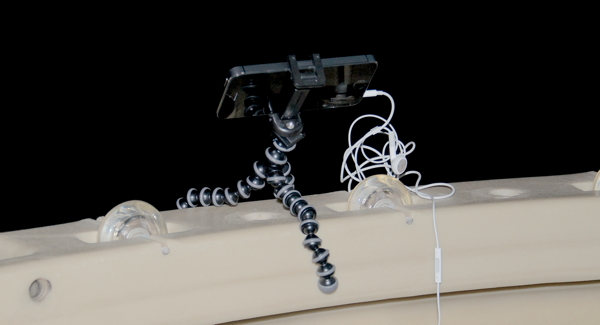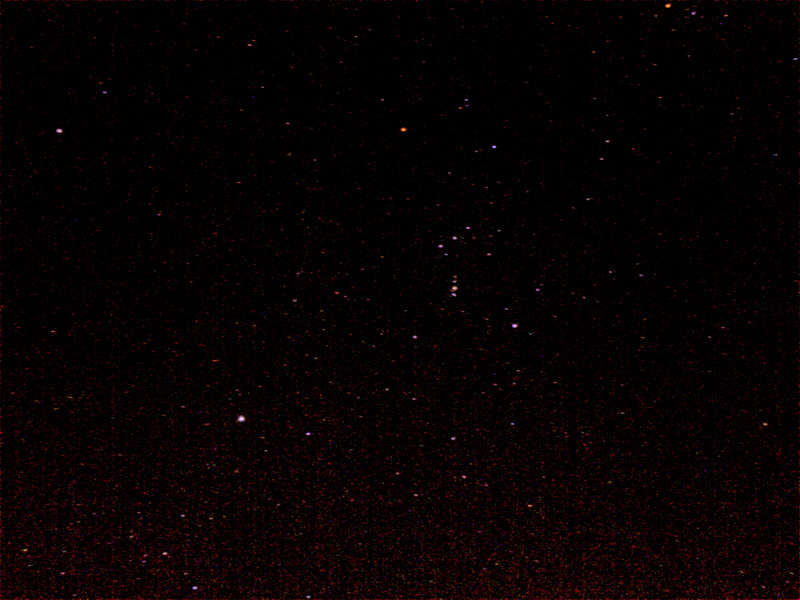iPhone NightCap Pro M42 Stacked,
D7000 DSLR Jupiter Moons Tests
Posted: 7 March 2015
|
Open: Friday, 6 March 2015, 1815 MST Temperature: 71°F |
Session: 789 Conditions: Clear, few clouds in SW |
1822 MST: viewed Venus, 83X. Gibbous phase visible. 1826 MST: sunset. Switched to 231X (using a 3X TeleXtender). Seeing was not good enough for this much magnification. Removed the TeleXtender and mounted the iPhone 5s using the Magnilux MX-1 Afocal Adapter, 77X. Did a 5 second slo-mo (120 fps) video recording. During post-processing I stacked the video (551 frames) using Keith's Image Stacker, with this result:

The gibbous phase is visible in the image.
1850 MST: slewed to M42 (Orion Nebula). The Trapezium was nice at 77X against a still bright sky. No nebulosity visible yet. 1858 MST: central nebulosity now visible.
1901 MST: slewed to Jupiter for a quick look, 77X. Three moons were visible. Callisto was being eclipsed by the planet's shadow and was not visible. Seeing was bad.
1909 MST: began setting up for sky photography of the constellation of Orion using NightCap Pro iOS app with the iPhone 5s. Attached the iPhone to a GorillaPod and secured it to the wall of the SkyShed POD while music was playing on my iPod (gee, lots of "pods" here).

In the photo above you can see that I use the earbuds/mic as a remote shutter release (by using the volume control buttons).
This is a 1 minute exposure using NightCap Pro:

The red color of the star Betelgeuse and M42 (Orion Nebula) is clearly visible. Part of the constellation Canis Major is at the lower left, with the star Procyon at the upper left. The iPhone with NightCap Pro certainly makes a fine camera for constellation photography.
1925 MST: eastern sky beginning to brighten from rising waning gibbous moon. Mounted the iPhone 5s on the 8" LX200-ACF using the MX-1 Afocal Adapter, 77X and began imaging M42 (Orion Nebula). This is a stack (using Lynkeos) of three 2-minute exposures at various settings using NightCap Pro:

Pretty amazing for a smartphone!!!
1945 MST: ended iPhone imaging.
1955 MST: viewed Jupiter, 83X. Seeing was better now, although it was beginning to get windy. Only three moons were still visible. Began setting up for imaging using the D7000 DSLR at prime focus + 3X TeleXtender. On the previous session I imaged Io occulting and then eclipsing Ganymede at prime focus + 2X PowerMate. This night I wanted to test various exposure settings for capturing Jupiter's moons at a higher magnification for upcoming Mutual Events. This first image is a composite of two images (1/160sec and 1/15sec, both at ISO 2500):

I then did some HD video recordings at 1/30sec using various ISO settings. This is a frame from the ISO 6400 recording:

Weather permitting, I will use this setting for the next Mutual Event Saturday night, 7 March.
2017 MST: completed imaging tests. There were some strong wind gusts now. Decided to close up for the night.
|
Close: Friday, 6 March 2015, 2033 MST Temperature: 56°F |
|
Comments are welcome using Email. If you are on Twitter you can use the button below to tweet this report to your followers. Thanks.
Cassiopeia Observatory Home Page
Copyright ©2015 Michael L. Weasner / mweasner@me.com
URL = http://www.weasner.com/co/Reports/2015/03/07/index.html
